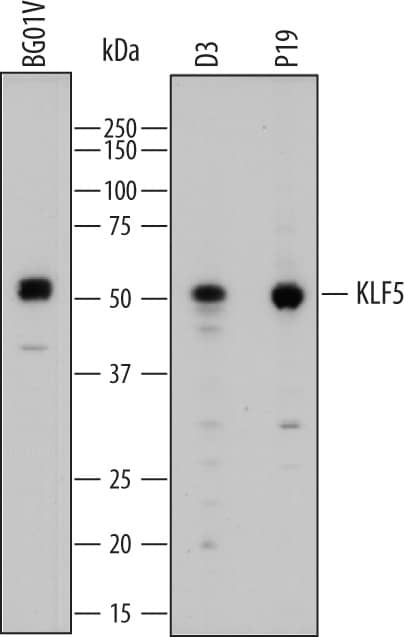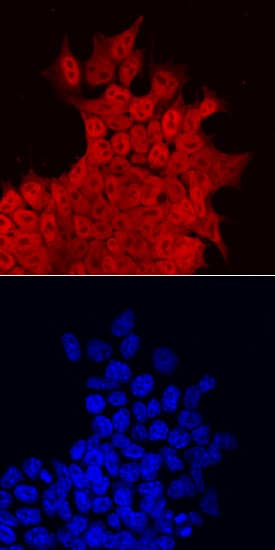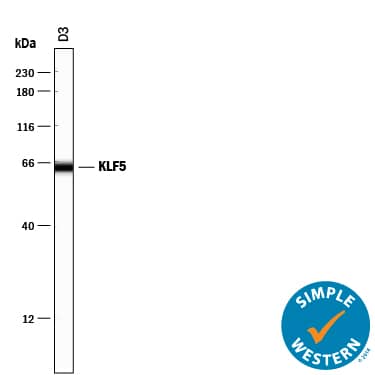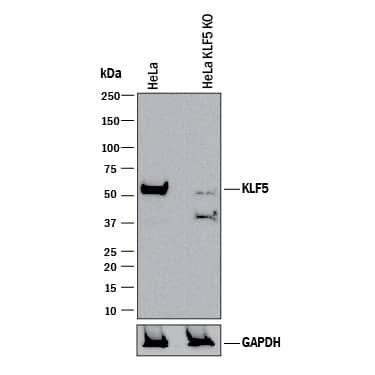Human/Mouse KLF5 Antibody Summary
Leu85-Ala177
Accession # Q13887
Applications
Please Note: Optimal dilutions should be determined by each laboratory for each application. General Protocols are available in the Technical Information section on our website.
Scientific Data
 View Larger
View Larger
Detection of Human and Mouse KLF5 by Western Blot. Western blot shows lysates of BG01V human embryonic stem cells, D3 mouse embryonic stem cell line, and P19 mouse embryonal carcinoma cell line. PVDF membrane was probed with 1 µg/mL of Goat Anti-Human KLF5 Antigen Affinity-purified Polyclonal Antibody (Catalog # AF3758) followed by HRP-conjugated Anti-Goat IgG Secondary Antibody (Catalog # HAF109). A specific band was detected for KLF5 at approximately 50-55 kDa (as indicated). This experiment was conducted under reducing conditions and using Immunoblot Buffer Group 1.
 View Larger
View Larger
KLF5 in D3 Mouse Stem Cells. KLF5 was detected in immersion fixed D3 mouse embryonic stem cell line using Goat Anti-Human KLF5 Antigen Affinity-purified Polyclonal Antibody (Catalog # AF3758) at 10 µg/mL for 3 hours at room temperature. Cells were stained using the NorthernLights™ 557-conjugated Anti-Goat IgG Secondary Antibody (red, upper panel; Catalog # NL001) and counterstained with DAPI (blue, lower panel). Specific staining was localized to nuclei and cytoplasm. View our protocol for Fluorescent ICC Staining of Cells on Coverslips.
 View Larger
View Larger
Detection of Mouse KLF5 by Simple WesternTM. Simple Western lane view shows lysates of D3 mouse embryonic stem cell line, loaded at 0.2 mg/mL. A specific band was detected for KLF5 at approximately 64 kDa (as indicated) using 10 µg/mL of Goat Anti-Human/Mouse KLF5 Antigen Affinity-purified Polyclonal Antibody (Catalog # AF3758) followed by 1:50 dilution of HRP-conjugated Anti-Goat IgG Secondary Antibody (Catalog # HAF109). This experiment was conducted under reducing conditions and using the 12-230 kDa separation system.
 View Larger
View Larger
Western Blot Shows Human KLF5 Specificity by Using Knockout Cell Line. Western blot shows lysates of HeLa human cervical epithelial carcinoma parental cell line and KLF5 knockout HeLa cell line (KO). PVDF membrane was probed with 1 µg/mL of Goat Anti-Human/Mouse KLF5 Antigen Affinity-purified Polyclonal Antibody (Catalog # AF3758) followed by HRP-conjugated Anti-Goat IgG Secondary Antibody (Catalog # HAF017). A specific band was detected for KLF5 at approximately 53 kDa (as indicated) in the parental HeLa cell line, but is not detectable in knockout HeLa cell line. GAPDH (Catalog # AF5718) is shown as a loading control. This experiment was conducted under reducing conditions and using Immunoblot Buffer Group 1.
Preparation and Storage
- 12 months from date of receipt, -20 to -70 °C as supplied.
- 1 month, 2 to 8 °C under sterile conditions after reconstitution.
- 6 months, -20 to -70 °C under sterile conditions after reconstitution.
Background: KLF5
Human KLF5, also known as basic transcription element binding protein 2 (BTEB2), is a widely expressed 51 kDa (457 aa) member of the kruppel C2H2-type zinc finger protein family. KLF5 contains three C2H2-type zinc fingers at the carboxyl-terminus that preferentially bind to cis-DNA elements that are GC rich. It is a transcription activator that promotes cell proliferation and oncogenesis. Over the region used as immunogen, human, mouse and canine KLF5 share 95% aa sequence identity.
Product Datasheets
Citations for Human/Mouse KLF5 Antibody
R&D Systems personnel manually curate a database that contains references using R&D Systems products. The data collected includes not only links to publications in PubMed, but also provides information about sample types, species, and experimental conditions.
17
Citations: Showing 1 - 10
Filter your results:
Filter by:
-
Krüppel-like Factor 5 Plays an Important Role in the Pathogenesis of Chronic Pancreatitis
Authors: Alavi, M;Mejia-Bautista, A;Tang, M;Bandovic, J;Rosenberg, AZ;Bialkowska, AB;
Cancers
Species: Mouse
Sample Types: Whole Tissues
Applications: IHC -
Targeting the KLF5-EphA2 axis can restrain cancer stemness and overcome chemoresistance in basal-like breast cancer
Authors: P Zhao, J Sun, X Huang, X Zhang, X Liu, R Liu, G Du, W Gan, C Yang, Y Tang, C Chen, D Jiang
International journal of biological sciences, 2023-03-21;19(6):1861-1874.
Species: Human
Sample Types: Cell Lysate
Applications: Western Blot, ChIP -
Histone Deacetylase Inhibitors (HDACi) Promote KLF5 Ubiquitination and Degradation in Basal-like Breast Cancer
Authors: Y Kong, W Ren, H Fang, NA Shah, Y Shi, D You, C Zhou, D Jiang, C Yang, H Liang, W Liu, L Wang, W Gan, X Wan, F Li, Z Li, C Chen, N Xie
International journal of biological sciences, 2022-02-28;18(5):2104-2115.
Species: Human
Sample Types: Cell Lysates
Applications: Western Blot -
Lgr6 marks epidermal stem cells with a nerve-dependent role in wound re-epithelialization
Authors: S Huang, P Kuri, Y Aubert, M Brewster, N Li, O Farrelly, G Rice, H Bae, S Prouty, T Dentchev, W Luo, BC Capell, P Rompolas
Cell Stem Cell, 2021-06-07;0(0):.
Species: Mouse
Sample Types: Whole Tissue
Applications: IHC -
KLF5 Is Crucial for Androgen-AR Signaling to Transactivate Genes and Promote Cell Proliferation in Prostate Cancer Cells
Authors: J Li, B Zhang, M Liu, X Fu, X Ci, J A, C Fu, G Dong, R Wu, Z Zhang, L Fu, JT Dong
Cancers (Basel), 2020-03-21;12(3):.
Species: Human
Sample Types: Whole Cells
Applications: ChIP -
The aging skin microenvironment dictates stem cell behavior
Authors: Y Ge, Y Miao, S Gur-Cohen, N Gomez, H Yang, M Nikolova, L Polak, Y Hu, A Verma, O Elemento, JG Krueger, E Fuchs
Proc. Natl. Acad. Sci. U.S.A., 2020-02-24;0(0):.
Species: Mouse
Sample Types: Whole Tissue
Applications: IHC -
Targeting the cytoskeleton to direct pancreatic differentiation of human pluripotent stem cells
Authors: NJ Hogrebe, P Augsornwor, KG Maxwell, L Velazco-Cr, JR Millman
Nat. Biotechnol., 2020-02-24;0(0):.
Species: Human
Sample Types: Cells
Applications: ICC -
HIV-1-induced cytokines deplete homeostatic innate lymphoid cells and expand TCF7-dependent memory NK cells
Authors: Y Wang, L Lifshitz, K Gellatly, CL Vinton, K Busman-Sah, S McCauley, P Vangala, K Kim, A Derr, S Jaiswal, A Kucukural, P McDonel, PW Hunt, T Greenough, J Houghton, M Somsouk, JD Estes, JM Brenchley, M Garber, SG Deeks, J Luban
Nat. Immunol., 2020-02-17;21(3):274-286.
Species: Human
Sample Types: Cells
Applications: ICC -
USP3 promotes breast cancer cell proliferation by deubiquitinating KLF5
Authors: Y Wu, J Qin, F Li, C Yang, Z Li, Z Zhou, H Zhang, Y Li, X Wang, R Liu, Q Tao, W Chen, C Chen
J. Biol. Chem., 2019-10-17;0(0):.
Species: Human
Sample Types: Cell Lysates
Applications: Immunoprecipitation -
HDAC-mediated deacetylation of KLF5 associates with its proteasomal degradation
Authors: R Tao, B Zhang, Y Li, JL King, R Tian, S Xia, CR Schiavon, JT Dong
Biochem. Biophys. Res. Commun., 2018-04-24;0(0):.
Species: Human
Sample Types: Cell Lysates
Applications: Immunoprecipitation, mmunoprecipitation -
Stem Cell Lineage Infidelity Drives Wound Repair and Cancer
Authors: Y Ge, NC Gomez, RC Adam, M Nikolova, H Yang, A Verma, CP Lu, L Polak, S Yuan, O Elemento, E Fuchs
Cell, 2017-04-20;0(0):.
Species: Mouse
Sample Types: Whole Tissue
Applications: IHC -
KLF13 regulates the differentiation-dependent human papillomavirus life cycle in keratinocytes through STAT5 and IL-8
Authors: W Zhang, S Hong, KP Maniar, S Cheng, C Jie, AW Rademaker, AM Krensky, C Clayberger
Oncogene, 2016-04-04;0(0):.
Species: Human
Sample Types: Cell Lysates
Applications: Western Blot -
The intestinal epithelial cell differentiation marker intestinal alkaline phosphatase (ALPi) is selectively induced by histone deacetylase inhibitors (HDACi) in colon cancer cells in a Kruppel-like factor 5 (KLF5)-dependent manner.
Authors: Shin J, Carr A, Corner G, Togel L, Davaos-Salas M, Tran H, Chueh A, Al-Obaidi S, Chionh F, Ahmed N, Buchanan D, Young J, Malo M, Hodin R, Arango D, Sieber O, Augenlicht L, Dhillon A, Weber T, Mariadason J
J Biol Chem, 2014-07-18;289(36):25306-16.
Species: Human
Sample Types: Cell Lysates
Applications: ChIP -
Epithelial microRNAs regulate gut mucosal immunity via epithelium-T cell crosstalk.
Authors: Biton M, Levin A, Slyper M, Alkalay I, Horwitz E, Mor H, Kredo-Russo S, Avnit-Sagi T, Cojocaru G, Zreik F, Bentwich Z, Poy MN, Artis D, Walker MD, Hornstein E, Pikarsky E, Ben-Neriah Y
Nat. Immunol., 2011-01-30;12(3):239-46.
Species: Mouse
Sample Types: Cell Lysates, Whole Tissue
Applications: IHC-P, Western Blot -
KLF5 inhibition potentiates anti-PD1 efficacy by enhancing CD8+ T-cell-dependent antitumor immunity
Authors: Q Wu, Z Liu, Z Gao, Y Luo, F Li, C Yang, T Wang, X Meng, H Chen, J Li, Y Kong, C Dong, S Sun, C Chen
Theranostics, 2023-02-21;13(4):1381-1400.
-
Novel Antibody Exerts Antitumor Effect through Downregulation of CD147 and Activation of Multiple Stress Signals
Authors: Keisuke Fukuchi, Kayoko Nanai, Hiroshi Yuita, Chikako Maru, Jun Tsukada, Masato Ishigami et al.
Journal of Oncology
-
Kr�ppel-like factor 5 regulates stemness, lineage specification, and regeneration of intestinal epithelial stem cells
Authors: CK Kim, M Saxena, K Maharjan, JJ Song, KR Shroyer, AB Bialkowska, RA Shivdasani, VW Yang
Cell Mol Gastroenterol Hepatol, 2019-11-25;0(0):.
FAQs
No product specific FAQs exist for this product, however you may
View all Antibody FAQsIsotype Controls
Reconstitution Buffers
Secondary Antibodies
Reviews for Human/Mouse KLF5 Antibody
There are currently no reviews for this product. Be the first to review Human/Mouse KLF5 Antibody and earn rewards!
Have you used Human/Mouse KLF5 Antibody?
Submit a review and receive an Amazon gift card.
$25/€18/£15/$25CAN/¥75 Yuan/¥2500 Yen for a review with an image
$10/€7/£6/$10 CAD/¥70 Yuan/¥1110 Yen for a review without an image


